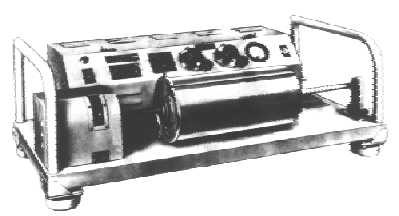3-35
Facsimile
FACSIMILE (fax) is a method of transmitting still images over an electrical communications
system. The images, called "pictures" or "copy" in fax terminology, may be weather maps, photographs,
sketches, typewritten or printed text, or handwriting. Figure 3-32 shows a facsimile transceiver. You must
realize that the still image serving as the fax copy or picture cannot be transmitted instantly in its entirety.
Three distinct operations are performed. These are (1) scanning, (2) transmitting, and (3) recording or
receiving.
Figure 3-32.—Facsimile transceiver.
Scanning consists of subdividing the picture in an orderly manner into a large number of segments.
This process is accomplished in the fax transmitter by a scanning drum and phototube arrangement.
The picture you want to transmit is mounted on a cylindrical scanning drum. This drum rotates at a
constant speed and at the same time moves longitudinally along a shaft. Light from an exciter lamp
illuminates a small segment of the moving picture and is reflected by the picture through an aperture to a
phototube. During picture transmission, the light crosses every segment of the picture as the drum slowly
spirals past the fixed lighted area.
The amount of light reflected back to the phototube is a measure of the lightness or darkness of the
segment of the picture being scanned. The phototube changes the varying amounts of light into electrical
signals. These are used to amplitude modulate the constant frequency output of a local oscillator. The
modulated signal is then amplified and sent to the radio circuits.
Signals received by the fax receiver are amplified and actuate a recording mechanism. This recorder
makes a permanent recording (segment by segment) on paper. The paper is attached to a receiver drum
similar to the one in the fax transmitter. The receiver drum rotates synchronously with the transmitter
drum. Synchronization of the receiver and transmitter is done to reduce distortion. Synchronization is
obtained by driving both receiver and transmitter drums with synchronous motors operating at the same
speed. Drum rotation continues until the original picture is reproduced. The recording mechanism may
reproduce the picture photographically by using a modulated light source shining on photographic paper
or film. It may also reproduce directly by burning a white protective coating from specially prepared
black recording paper.
The receiver drum is FRAMED with respect to the transmitter drum by a series of phasing pulses
that are transmitted just before transmission. The pulses operate a clutch mechanism that starts the

